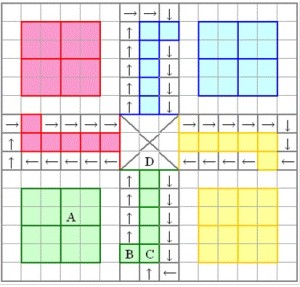The rules of Norske Kimble
Each team (4 total) must have 4 cups coloured according to their team and capable of holding 1/3 l of liquid at their disposal. The cups must be of equal size or there must be a mark at 1/3 l. The teams must have enough beer, cider, long drink or vichy available in 0,33 l unopened cans or bottles. In addition, a dice and a gameboard are needed. 1 square on the board is 5-7 cm in width.
The board is coloured in four colours as shown below.
The circulation route is marked with arrows.
A = waiting area
B = starting point
C = beginning of final stretch
D = home (end of final stretch)

Gameplay
In the beginning the cups are placed in the waiting area on the large squares, each team according to their colour. The teams take turns throwing the die and moving a cup that is in play the distance indicated by the die. The cups move clockwise. Turns also circulate clockwise. A cup is in play if it is not in the waiting area or at home (D) in the triangle in the middle of the board.
If a team has no cups in play, they may roll the die three (3) times. Once they roll the number six (6), they may bring one cup into play. This means that the cup is moved from the waiting area to the starting point (B) and a drink is opened. The drink is not poured into the cup until the cup is eaten lest beer be allowed to spill. It is not mandatory to bring a new cup into play when rolling a six; the team may also move a cup already in play. After rolling a six, the team may throw the die once more.
The starting point marked with a team’s colour is protected and that team’s cup may not be eaten from that square. If a team has a cup in its own starting point, another team may not move a cup into this square. If they have no other cup to move and must move into this square, the cup gets eaten.
If a team has multiple cups in their starting point simultaneously, these become a battery. Once a battery is formed, it is treated just as a single cup is treated. A battery cannot be dissassembled unless it is eaten. In this case one of the team members must empty all the cups in the battery. There is no other way for a team to have multiple cups in the same square. If a team cannot move a cup into a square without a cup of theirs, one of the cups is eaten.
If a cup after moving the amount indicated by the die enters a square already populated by a cup or battery of another team, all of the latter are eaten. The exception here is the starting point. Passing another team’s cup does not result in it being eaten.
Once a cup is eaten one of the members of the team whose cup it was must fill the cup with 33 cl of a drink and empty it instantly. Time to finish the cup is 45 seconds. In the case of a battery a 30 second break may be taken between cups. The break begins immediately after emptying the first cup if less than 45 seconds have passed. Countdown begins at the referees signal, when the cup must be on the table, and ends when the cup (now empty) is replaced on the table. The cup does not need to be emptied in one go. The game is not continued until the cup is empty. The empty cup is replaced in the waiting area. Team members decide amongst themselves, who empties the cup. If, however, one player is not capable, s/he is shut out of the game. If they wish to do so, the team may go on with only one member. In this case, any unfinished cups are refilled and the remaining player must empty them. If the team is mixed in gender, the player must drink a drink of appropiate strength.
After emptying a cup, a player must remain at the table for five (5) minutes. After this they may use the restroom. Vomiting results in immediate disqualification. If the player who drank the previous round vomits within five minutes, their teammate must redrink the round (if they wish to continue solo).
Once a cup has circled the board and come to the beginning of the final stretch, it continues towards the center of the board. The cup must reach home, which is the triangle in the middle, with an even roll. If the die shows a number too large, the cup may not be moved. If a team cannot move any cups, the turn mvoes to the next team.
Once a cup reaches home, it must be emptied in the manner explained above before the game continues. Cups that reach home remain there. The game is won by the team that first manages to bring all their cups home.
In controversial situations the referee makes any necessary calls and players must obey any decision made by the referee.